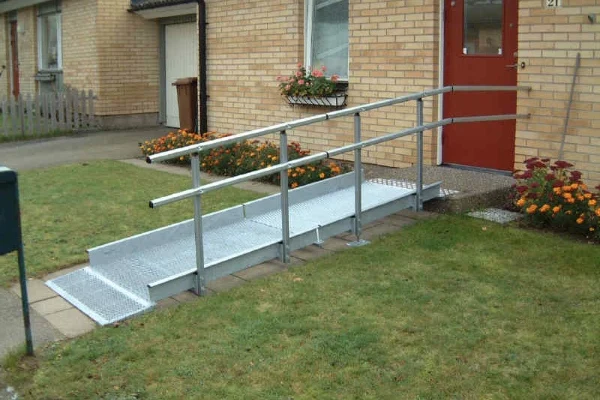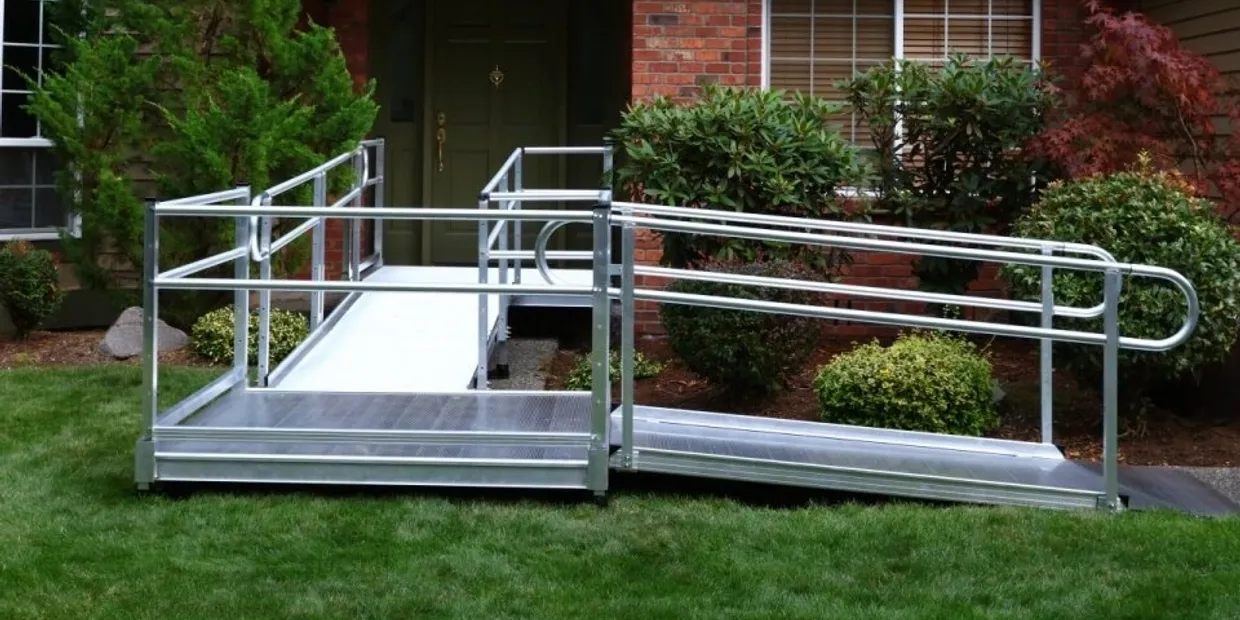In contemporary architecture, modular ramp systems address accessibility needs seamlessly. Functionality blends with aesthetics to redefine inclusive living environments. These structures harmonize with the architectural framework, creating visually appealing, accessible homes catering to diverse needs.
Key Takeaways
- Versatile installation options cater to various entry points
- Design considerations prioritize seamless integration with home aesthetics
- Simplified installation process with customizable modular design
- Maintenance tips focus on the longevity and safety of modular ramp systems
The Importance of Home Accessibility
Home accessibility is a fundamental aspect that plays a pivotal role in ensuring that every individual, irrespective of their physical abilities, can enjoy equal opportunities and independence within their living spaces. The significance of home accessibility goes beyond just physical entry; it encompasses the idea of creating an inclusive environment where everyone feels a sense of belonging and can navigate their surroundings with ease.
For individuals with mobility challenges, having a home that is accessible means they can move freely and confidently, without limitations hindering their daily activities. This freedom not only promotes physical well-being but also nurtures mental and emotional health by fostering a sense of autonomy and self-reliance.
Understanding modular ramp systems as a key component in enhancing home accessibility is crucial. These innovative systems provide a practical solution that seamlessly integrates with modern living spaces, offering a safe and convenient way for individuals with mobility issues to access different areas of their homes. By incorporating modular ramp systems, homes can be transformed into inclusive environments that prioritize the well-being and independence of all residents.

Benefits of Modular Ramp Systems
Enhancing home accessibility with modular ramp systems offers a transformative solution that greatly improves the mobility and independence of individuals facing physical challenges. These systems not only provide a way for individuals with mobility impairments to navigate their homes safely but also bring a host of additional benefits that seamlessly integrate with modern living spaces.
One of the key advantages of modular ramp systems is their versatility. They can be easily installed and adjusted to fit various entry points, whether it’s a front porch, back door, or sliding patio door. This adaptability ensures that individuals can move in and out of their homes with ease, regardless of the layout or design.
Moreover, modular ramp systems are durable and low-maintenance, requiring minimal upkeep once installed. This reliability ensures long-term use without significant wear and tear, providing a stable and secure pathway for individuals to access their homes confidently.
Design Considerations for Seamless Integration
With the focus on optimizing the functionality and aesthetic appeal of home accessibility solutions, careful attention to design considerations becomes paramount when seamlessly integrating modular ramp systems into modern living spaces. The seamless integration of modular ramps requires a delicate balance between functionality and design to ensure that the accessibility solution complements the existing aesthetics of the home.
When considering design aspects, it is essential to take into account the materials used for the ramp construction. Opting for materials that harmonize with the surroundings can enhance the overall appeal of the living space. Additionally, the color and finish of the ramp should blend seamlessly with the architectural elements of the home to create a cohesive look.
Furthermore, the layout and placement of the ramp are crucial in maintaining the flow of the living space. Thoughtful positioning of the ramp can ensure that it does not obstruct pathways or disrupt the overall design scheme. By carefully considering these design elements, modular ramp systems can seamlessly integrate into modern living spaces, enhancing accessibility without compromising on style.
Installation Process Simplified
Simplified Installation Process for Modular Ramp Systems greatly streamlines the setup for enhanced accessibility in modern living spaces. When it comes to installing modular ramp systems, the process has been made user-friendly to ensure a hassle-free experience for homeowners seeking to improve accessibility in their homes.
- Modular Design: The modular nature of these ramp systems allows for easy customization and flexibility during installation, catering to the specific needs of each home without the need for extensive modifications.
- Tool-Free Assembly: Many modern modular ramp systems are designed for tool-free assembly, making it convenient for homeowners to set up the ramps without the requirement of specialized tools or equipment.
- Step-by-Step Instructions: Clear and concise step-by-step instructions are provided with modular ramp systems, guiding homeowners through the installation process smoothly and efficiently.
- Professional Assistance: For those who prefer additional support, professional installation services are often available, ensuring the ramps are set up correctly and securely for optimal functionality and safety.
Maintenance Tips for Longevity
For optimal functionality and longevity of modular ramp systems in home accessibility, regular maintenance is key to ensuring their continued safety and reliability. Just like any other part of your home, modular ramps require care and attention to remain in top condition. Here are some practical maintenance tips to help you keep your modular ramp system in excellent shape for years to come.
Firstly, conduct regular visual inspections. Check for any signs of wear and tear, loose bolts, or uneven surfaces. Addressing these issues promptly can prevent further damage and ensure the safety of users.
Secondly, clean your ramp regularly to prevent the buildup of debris, which can create slip hazards. Use a gentle detergent and a soft brush to remove dirt and grime.
Additionally, lubricate moving parts such as hinges and locks to keep them functioning smoothly.
Enhancing Safety and Independence
To cultivate a secure and autonomous living environment, prioritizing safety measures and fostering self-reliance are paramount considerations when integrating modular ramp systems within modern living spaces. The seamless integration of these systems not only enhances accessibility but also promotes a sense of well-being and independence for individuals with mobility challenges.
Empowering Safety and Independence Through Modular Ramp Systems
- Non-Slip Surfaces: Implementing non-slip surfaces on modular ramps ensures traction and stability, reducing the risk of slips and falls.
- Handrails: Installing sturdy handrails along the ramps provides additional support for users, enhancing safety and confidence during navigation.
- Proper Lighting: Adequate lighting along the ramp areas improves visibility, aiding users in safely traversing the space, especially during low-light conditions.
- Clear Signage: Clear and concise signage indicating ramp access points and any potential hazards helps users navigate with ease and promotes a sense of security.
Frequently Asked Questions
Can Modular Ramp Systems Be Customized to Fit Different Home Layouts and Styles?
Yes, modular ramp systems can indeed be customized to suit various home layouts and styles. Through innovative design and practical installation techniques, these ramps can seamlessly integrate into any living space, ensuring accessibility without compromising the aesthetic appeal of the home.
Are Modular Ramp Systems Easy to Disassemble and Move to a New Location if Needed?
Modular ramp systems are designed for easy disassembly and relocation, ensuring flexibility for changing needs. With their adaptable nature, these ramps can be seamlessly moved to new locations, providing accessibility solutions wherever they are required.
What Materials Are Commonly Used in the Construction of Modular Ramp Systems?
Commonly used materials in modular ramp systems include aluminum for its durability and lightweight properties, steel for strength, and composite materials for a balance of durability and aesthetics. These materials ensure a safe and reliable ramp structure.
Are There Any Specific Weight or Load-Bearing Requirements for Modular Ramp Systems?
Modular ramp systems are designed to meet specific weight and load-bearing requirements. Understanding these specifications is crucial to ensure the ramp’s safety and durability. Consult with professionals to determine the appropriate weight limits for your modular ramp system.
How Do Modular Ramp Systems Compare to Traditional Permanent Ramp Installations in Terms of Cost and Flexibility?
When comparing modular ramp systems to traditional permanent installations in terms of cost and flexibility, modular ramps offer a more cost-effective and adaptable solution. Their modular nature allows for easy installation, customization, and reconfiguration as needed, providing greater flexibility for changing accessibility needs.
Conclusion
In conclusion, the integration of modular ramp systems into modern living spaces is essential for enhancing home accessibility and creating a more inclusive environment for individuals with mobility challenges.
By prioritizing both functionality and aesthetics, these ramp systems seamlessly blend into contemporary designs while ensuring safety and ease of use for all occupants.
Embracing universal design principles, the use of modular ramps exemplifies a forward-thinking approach to creating welcoming and barrier-free homes.
You may also like to read:
Acupuncture’s Contribution to Headache Relief in Home Spaces


